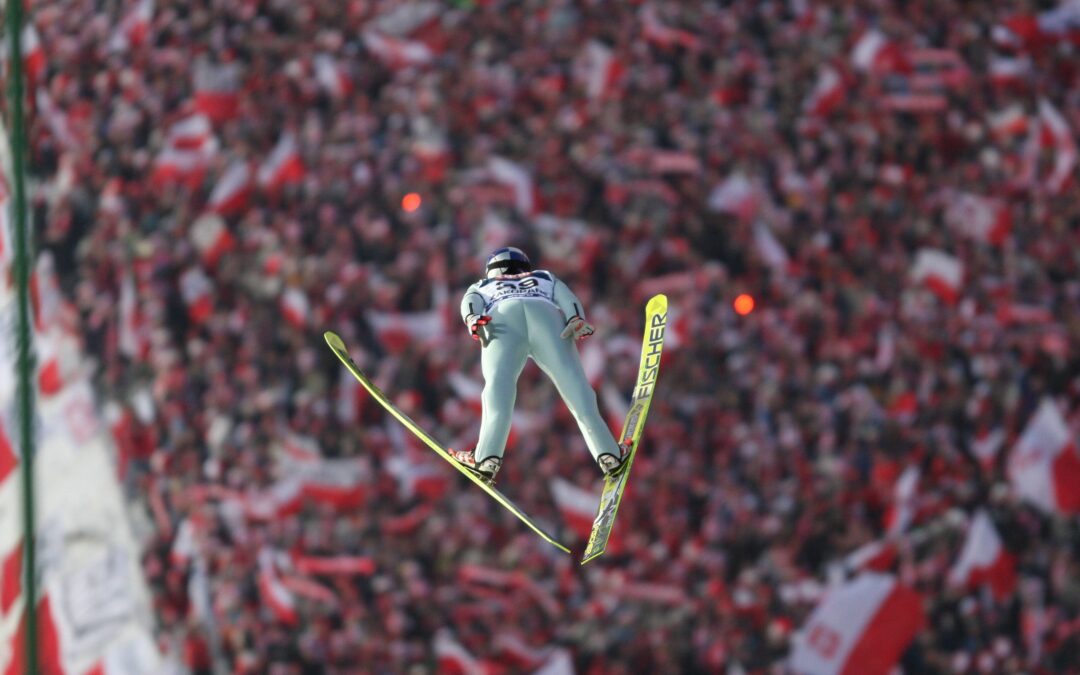By Adrian Dworakowski
Every January, tens of thousands of fans gather in Poland’s winter capital, Zakopane, to cheer on the nation’s ski jumpers at the annual World Cup event. Millions more around the country are glued to their TVs. The fact that this eccentric winter sport has become a national obsession is thanks in large part to one man: four-time World Cup winner Adam Małysz.
At the height of his success in first decade of this century, “Małyszmania” gripped Poland, creating a strong emotional attachment to the sport, stirring national pride, and inspiring the next generation of ski jumpers. As sports commentator Włodzimierz Szaranowicz put it:
“Every week we would sit down, as if for a soap opera, to watch the competition. Małysz was an idol in a crisis who led us as an ambassador for our great civilisational leap to Europe. Those broadcasts allowed us to live vicariously. He brought enormous shared joy.”
Before the Polish eagle flew
Ski jumping is a minority sport in global terms, practised seriously only in around a dozen countries. Its traditions in Poland stretch back to the first decade of the 20th century. Although the discipline was never able to compete with popular sports such as football, volleyball, athletics and speedway, Poland did have several figures whose successes shaped the development of ski jumping in the country.
Before the Second World War, one of few jumpers from outside of northern Europe who managed to break the Scandinavian hegemony was the Pole Stanisław Marusarz, silver medallist at the world championships in Lahti in 1938. In addition to his sporting achievements, he also became known for his patriotic endeavours during the war, and his life story is a ready-made movie script.
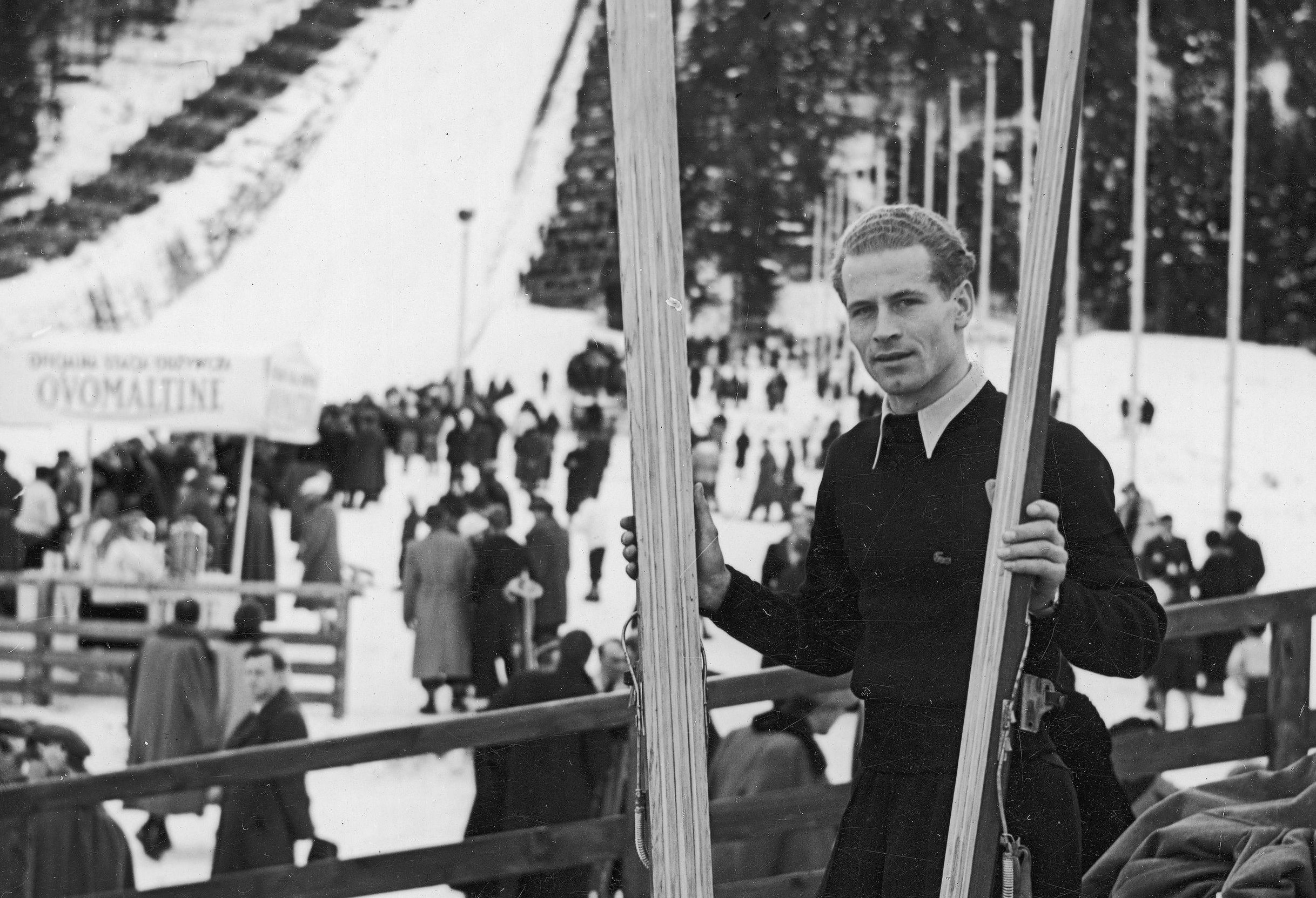
Stanisław Marusarz in Zakopane, 1939 (Narodowe Archiwum Cyfrowe)
In 1972, the 19-year-old Wojciech Fortuna, with a touch of fortune in keeping with his name, won Olympic gold in Sapporo. But the young Zakopane native was not prepared for such success and struggled with the burden of fame. His life story would also make a good film, albeit a cautionary tale about the dangers of addiction.
Several other Polish names feature in the annals of ski jumping history: Antoni Łaciak and Stanisław Gąsienica-Daniel won world championship medals, Stanisław Bobak came third in the inaugural edition of the World Cup in the 1979/80 season, and Piotr Fijas for seven years held the world record in ski flying.
The panacea for Poland’s ills
In the mid-1990s, a slight teenager from the small town of Wisła, in the Beskid mountains close to the Czech border, caught the eye after a few good jumps on hills around the world, but his form did not last long. Many gave up on the youngster, seeing him as a squandered talent. The young Adam Małysz himself seriously considered quitting the sport and going back to the tinning and roofing trades he had learnt.
At this time, though, a new coach of the national squad brought in a team of the best specialists in their fields – both physiological and psychological. Małysz’s performances improved, although nobody could foresee how successful he would become.
His breakthrough came in the 2000-2001 season with victory in the Four Hills Tournament, a prestigious annual event taking place in Germany and Austria.
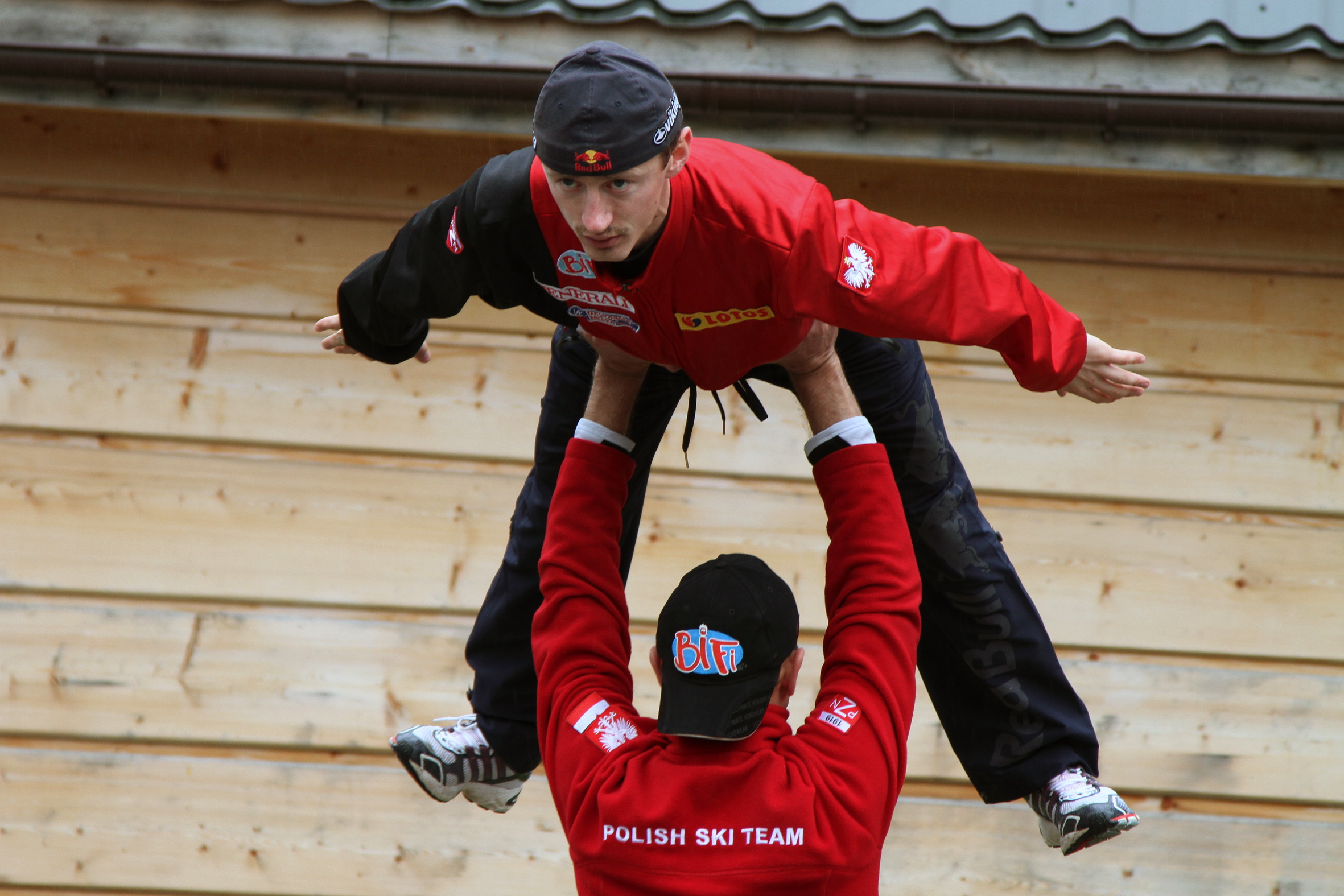
Małysz training during the Polish ski jumping championships in Zakopane, 2009 (Marek Podmoly/Agencja Wyborcza.pl)
It was not the win alone that was impressive, but the style with which the Polish jumper dispatched his rivals. In boxing terms, he knocked out the rest of the world and made them fetch their teeth from around the ring. And this was only a prelude to Małysz’s domination on the global ski jumping scene.
Around the beginning of the 21st century, fans of Polish sport did not have much to shout about. Małysz came along at the right time, his outstanding form giving Poles a hero of the sporting world.
More broadly, he helped to heal the complexes of a country that, only a decade or so earlier, had emerged from half a century of Soviet occupation and – not yet a member of the European Union – was still searching for a sense of its place in the world.
It was at this point that a sporting hero came along who showed that nothing is impossible for Poles – that they can literally fly. For a few years at the beginning of the century, Małysz staged a triumphant tour of the world’s hills, achieving success after success.
At every ski jumping event, a sea of Polish flags and banners could be seen. As the journalist Michał Pol, who witnessed the birth of the Małysz legend for himself at the breakthrough 2000/2001 Four Hills Tournament, put it:
“The scale of Małyszmania will never be surpassed by adoration for any other Polish sportsperson. Right now we have the best footballer in the world [Robert Lewandowski], with very many fans, but there’s no comparison to how Adam caught our imagination.”
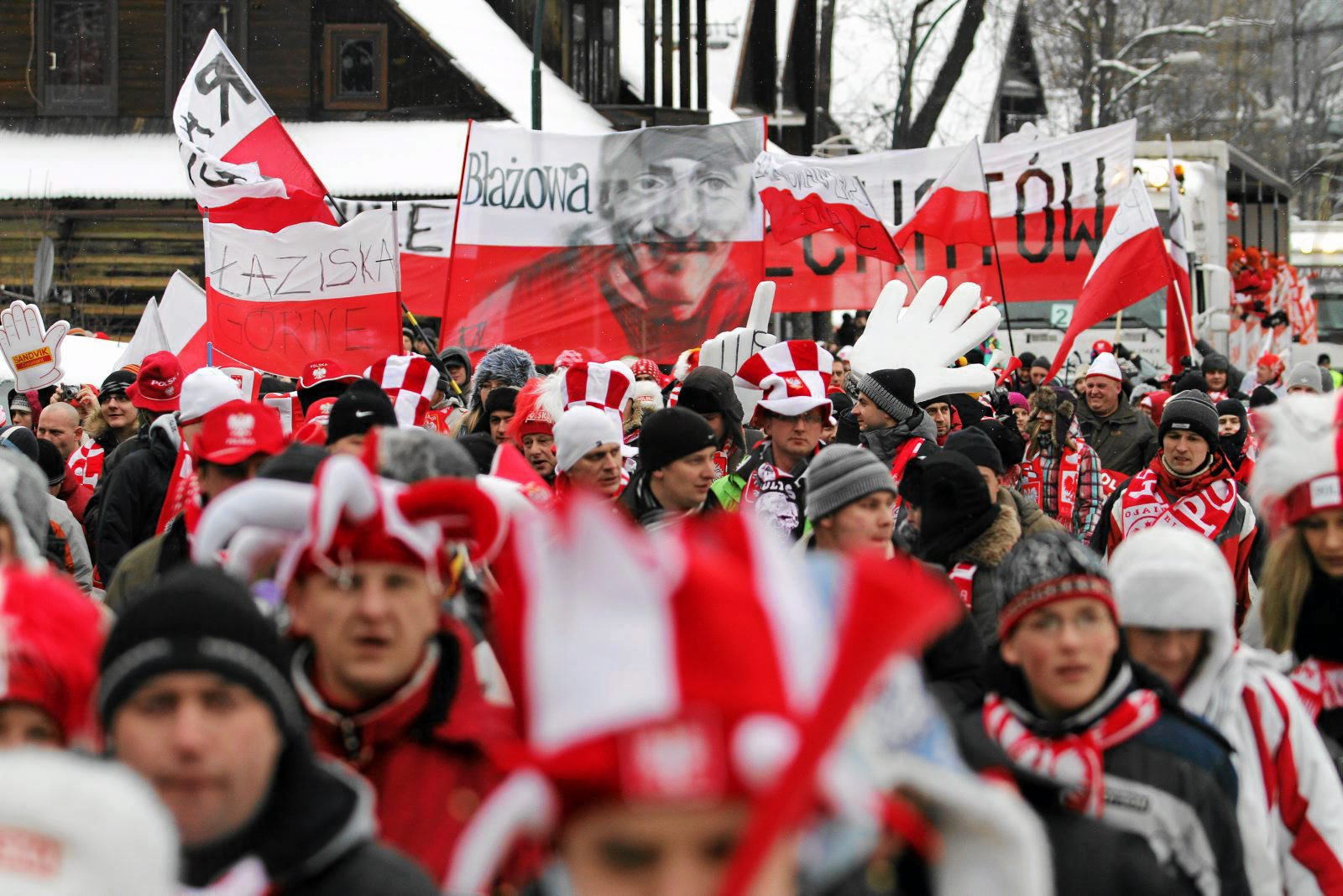
“Małyszmania” at the ski jumping World Cup in Zakopane, 2011 (Mateusz Skwarczak/Agencja Wyborcza.pl)
A social phenomenon
The phenomenon of Małyszmania went beyond Poland’s borders, reaching the Vatican (though Poland is 90% Catholic, Małysz himself is actually Lutheran). Pope John Paul II followed his compatriot’s successes avidly. In 2003, when Polish bishop Marek Jędraszewski was invited to dinner by the pope, he was told he had to wait a little. The pope was watching Małysz’s victorious jumps at the World Championships in Predazzo and had no intention to miss the conclusion.
In 2001, the champion became the first Polish sportsperson whose likeness was featured on a postage stamp that was not part of a series. The only other figures to receive this honour had been John Paul II himself, Oscar-winning director Andrzej Wajda, and Nobel laureate poets Wisława Szymborska and Czesław Miłosz.
Małysz’s successes also inspired musical artists. At one point there were so many songs in honour of Wisła’s favourite son that a festival of jumping music, with works extolling his successes, was held in the town.
The national hero’s autograph was always in demand, and at a “Mayday with Małysz” event in Wisła, he set a record, signing his name for fans non-stop for seven hours. He signed banknotes and people’s bodies, and once gave an autograph in a public toilet – “fortunately not on toilet paper,” he joked. One fan proffered his passport for his hero to sign. “Don’t be silly – they’ll lock me up for that,” Małysz said.

Fans donned Małysz-style moustaches in honour of their hero (Jakub Ociepa/Agencja Wyborcza.pl)
It was at the annual ski jumping weekend in Zakopane that Małyszmania was biggest. During the World Cup event there in 2002, when the Pole edged ahead of his German rival Sven Hannawald to take his first victory on home snow, the acceptable noise level was exceeded a thousand times, according to an analysis by the Tatra National Park, where the venues are located.
Such was the size of the army of fans watching at the foot of Giewont that the true figure is still not known. The most likely estimate is 60,000 spectators, more than double the number who could fit into the stands. The event far exceeded organisers’ expectations, and the ensuing scenes were extremely dangerous.
Małysz himself sometimes felt threated by fans obsessive behaviour. “These people went crazy. Two security guards walking next to me were almost crushed,” he said after a summer competition in Zakopane in 2001. “I asked the fans to go behind the barriers so everyone could get an autograph, but no one listened. I was really scared! I had to get away.”
History is still being written
Małysz became a model of hard work, a professional approach, and especially tenacity and perseverance. Weaker seasons followed, but he always returned close to the peak. He was also praised for never letting success go to his head. He remained himself, a modest lad from a small mountain town. His great career ended – after countless medals, trophies and other awards – in 2011,and with it came the end of an era in Polish history.
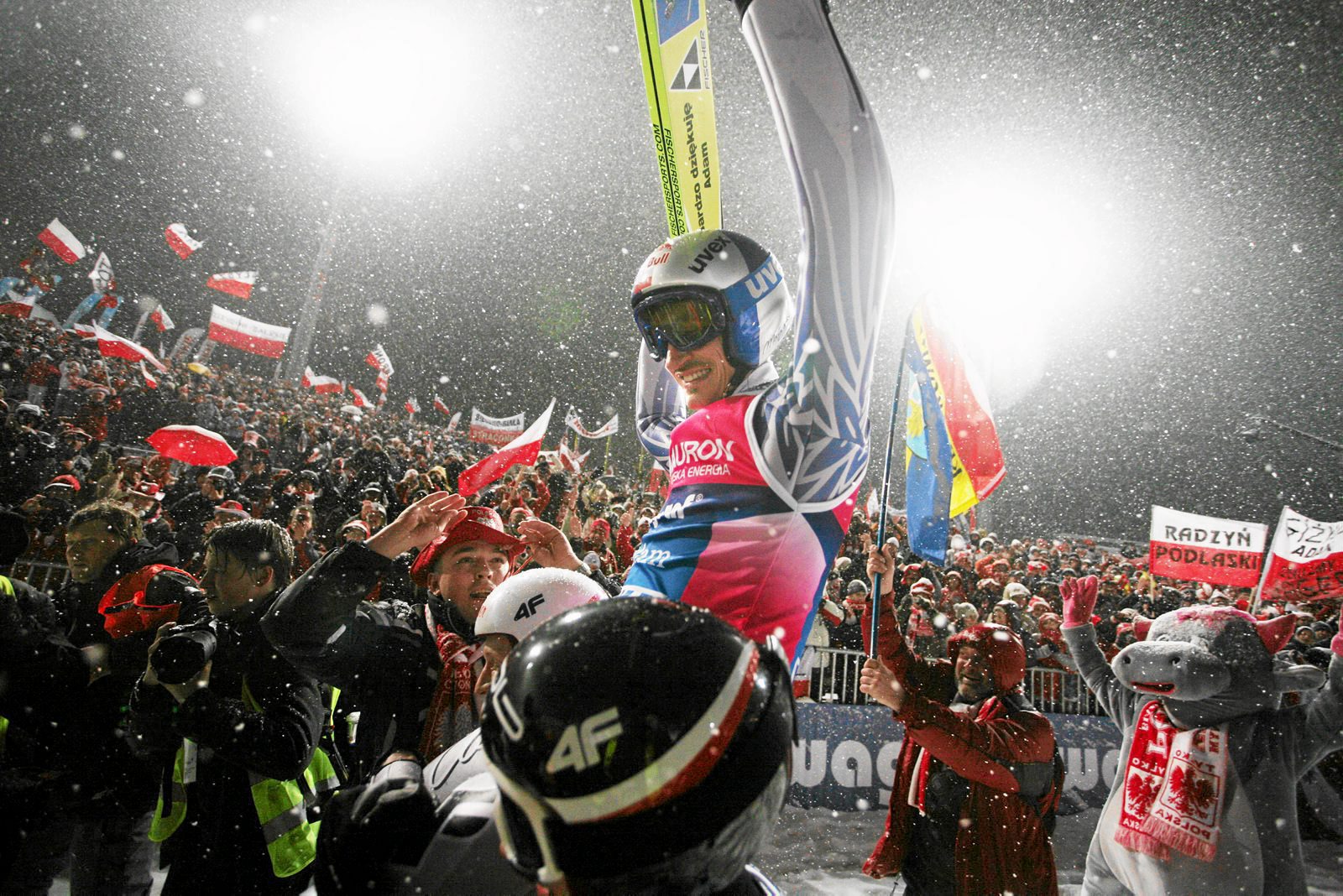
Małysz bids farewell to his fans at his final competitive jump in Zakopane, 2011 (Mateusz Skwarczek/Agencja Wyborcza.pl)
But it was by no means the end of Polish ski jumping success. His shoes were soon filled by compatriots who had grown up watching him jump, and Poland became a powerhouse in the sport. Among modern new facilities was a hill in Wisla, of course named after the town’s favourite son .
It is hard to believe, but one of his heirs, Kamil Stoch, has in fact surpassed the master’s achievements. He has taken home three Olympic gold medals – an honour that always eluded Małysz. Stoch has also won the Three Hills Tournament on three occasions, while Małysz never managed to repeat his 2000/2001 triumph.
There is no doubt that Stoch and other Polish jumpers would never have achieved the same success without Małysz laying the groundwork. He was the one who seized the moment and attracted sponsors for the national federation, who invested huge sums in the next generation. But Stoch, while popular, could never match the unique national frenzy of two decades ago.
Kamil #Stoch wins in #TitiseeNeustadt and ties the national record of Adam Małysz for the most victories in the ski jumping World Cup (39).
The two Polish are tied on the third place, only behind Matti Nikkänen (46) and Gregor Schlierenzauer (53).
📸 Adam Pretty pic.twitter.com/Y7tnnbVWXS
— Nase Epov (@epov88) January 9, 2021
The current Polish national ski jumping team boasts two other world champions, Piotr Żyła and Dawid Kubacki, both of whom have also enjoyed successes in Four Hills tournaments and World Cup events. In recent years, Jan Ziobro, Maciej Kot, Stefan Hula and Andrzej Stękała have also flourished.
Although ski jumping is an individual discipline, it also features team competitions in which the results of jumpers from the same country are tallied. In 2017 Poland’s men took gold at the World Championships in Lahti, Finland, and in recent years they have won a number of other medals.
This year, the results of the Polish jumpers, now overseen by Małysz as the team coordinator, are yet to match those in previous years. But a fervent belief remains that the legacy he started will continue, and the new generations of Polish ski jumpers will write further chapters of this sporting success story.
Translated by Ben Koschalka. Main image credit: Mateusz Skwarczak/Agencja Wyborcza.pl
